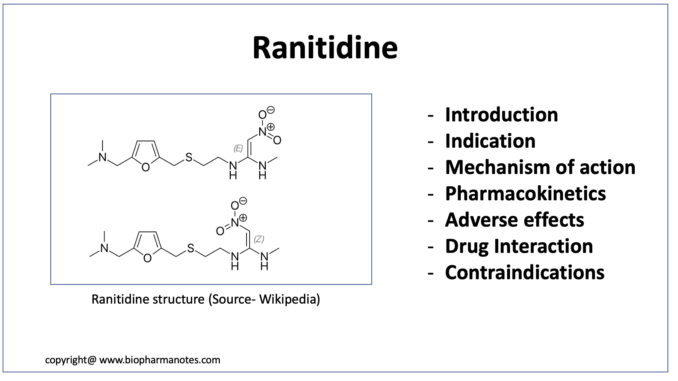
On April 1, 2020, FDA announced that it is requesting manufacturers to withdraw all prescription and over the counter (OTC) ranitidine drugs from the market due to contamination with nitrosodimethylamine (NDMA). Nitrosodimethylamine (NDMA) is a probable human carcinogen. Its use is discontinued in European Union and Australia due to the same reason.
Ranitidine
- Ranitidine is histamine H2 receptor antagonist. H2 receptor antagonist are first class of drug used for treating peptic ulcer, but their use nowadays is surpassed by PPI (proton pump inhibitors).
- Other H2 receptor antagonist available in market are cimetidine, roxatidine and famotidine. It was included in World Health Organization’s List of Essential Medicines and was one of the most prescribed histamine receptor antagonists. Ranitidine was available both as prescription and OTC medicine.
- Ranitidine is 4-5 times more potent than cimetidine.
Indications of ranitidine
Some of its FDA approved indications were:
- In short term treatment and maintenance of duodenal ulcer disease and benign gastric ulcer disease.
- To treat erosive esophagitis.
- In hypersecretory condition (Zollinger Ellison syndrome, multiple endocrine adenoma syndrome).
- To treat GERD (Gastric Esophageal Reflux Disease).
- In heart burn, indigestion, and non-ulcer dyspepsia.
Non-FDA approved indication include:
- Prophylaxis of NSAID induced ulcer and stress induced ulcer.
- Taxane related urticaria.
- Anaphylaxis.
Mechanism of action of ranitidine

- To understand mechanism of action of ranitidine, we should first understand mechanism of gastric acid secretion. The primary stimuli for gastric acid secretion include
- gastrin, released from antral G cells
- histamine released from oxyntic enterochromaffin-like cells
- acetylcholine released from antral and oxyntic neurons secondary to parasympathetic (vagal) stimulation.
- Other stimuli for gastric secretion include ghrelin and motilin.
- Histamine stimulates parietal cells by acting on H2 receptors. This is mediated by adenylate cyclase activation and generation of cyclic AMP (cAMP).
- Ranitidine is structurally similar to histamine. Hence, it competes with histamine for H2 receptor and cause competitive blockade of parietal cell H2 receptors.
- Binding of histamine to H2 receptors is one of the factors responsible for promoting gastric acid secretion. Hence, blockade of H2 receptors helps to reduce secretion of gastric acid and reduce both gastric acid volume and concentration.
- Ranitidine is more effective in lowering basal and nocturnal acid secretion compared to food related acid secretion.
Pharmacokinetics of Ranitidine
- Administered via oral, IV or IM route and is available as tablet, capsule, or oral syrup. Bioavailability after oral administration is 50%. It reaches peak -plasma concentration after 2-3 hours of oral administration and after around 15 minutes of IM administration.
- Around 15% of administered ranitidine binds to plasma proteins. Some of its metabolites are desmethyl ranitidine, ranitidine N-oxide and ranitidine S-oxide.
- It is excreted unchanged in urine. Hal-life is around 2-3 hours. In patients with renal dysfunction and in elderly patients, half-life may increase.
- It can cross placenta and is excreted in breast milk
Adverse Effects
- Some of its side effects include insomnia, mental confusion, dizziness, hallucinations, vomiting, pancreatitis, bradycardia, tachycardia, myalgia, arthralgia etc.
- It can also cause leukopenia, thrombocytopenia, agranulocytosis, pneumonia, decreased libido concentration, impotence etc.
Drug Interactions
- Unlike cimetidine, it doesn’t have anti-androgenic effect and doesn’t affect hepatic metabolism of other drugs.
- It may reduce efficacy of drugs like ketoconazole which require acidic environment for absorption.
Contraindications
- Contraindicated in patients who are hypersensitive to ranitidine.
- As it can trigger porphyria, patients with history of porphyria should avoid it.
- It is not used in children below 12 years of age.
- Should be used with caution in elderly and renal patients.
References
- https://go.drugbank.com/drugs/DB00863
- https://www.ncbi.nlm.nih.gov/books/NBK532989/
- https://link.springer.com/article/10.2165/00003495-198224040-00002
- Lippincott Illustrated Reviews Pharmacology, 6th edition.
- Pharmacology and pharmacotherapeutics. 24th edition.
- Goodman and Gillman Manual of Pharmacology and Therapeutics.